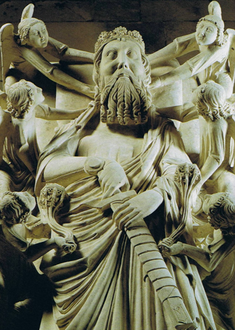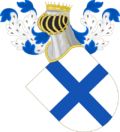Peter I of Portugal
| Peter I | |
|---|---|
 Recumbent effigy on the tomb of King Peter I (c. 1360), Alcobaça Monastery. | |
| King of Portugal and of the Algarve | |
| Reign | 28 May 1357 – 18 January 1367 |
| Predecessor | Afonso IV |
| Successor | Ferdinand I |
| Born | 8 April 1320 Coimbra, Kingdom of Portugal |
| Died | 18 January 1367 (aged 46) Estremoz, Kingdom of Portugal |
| Burial | Alcobaça Monastery, Portugal |
| Spouse | Constanza Manuel Inês de Castro (Disputed afterdeath queen) |
| Issue among others... | Maria, Marchioness of Tortosa Ferdinand I, King of Portugal Beatrice, Countess of Alburquerque John, Duke of Valencia de Campos Denis, Lord of Cifuentes John I, King of Portugal |
| House | House of Burgundy |
| Father | Afonso IV of Portugal |
| Mother | Beatrice of Castile |
| Religion | Roman Catholicism |
Peter I (Portuguese: Pedro I [ˈpedɾu] (8 April 1320 – 18 January 1367), called the Just or the Cruel) (Portuguese: o Justo, O Cruel), was King of Portugal and of the Algarves from 1357 until his death.[1] He was the third but only surviving son of Afonso IV of Portugal and his wife, Infanta Beatrice of Castile.
Early life
In 1328, Peter's father, Afonso IV arranged for the marriage of his eldest daughter, Maria, to Alfonso XI of Castile. In 1334, she bore him a son, who ultimately became Peter of Castile. However, Maria returned home to her father in Portugal in 1335 because her royal husband soon after their marriage had begun a long affair with the beautiful and newly widowed Leonor de Guzman, which the Castilian king refused to end. Alfonso's cousin, Juan Manuel, Prince of Villena, had been rebuffed by the Castilian king in 1327 when the two-year child marriage between his daughter Constanza (granddaughter of James II of Aragon) and Alfonso had been annulled to clear the way for the marriage to Maria. For two years Juan Manuel had waged war against the Castilians, who had kept Constanza hostage, until Bishop John del Campo of Oviedo mediated a peace in 1329.
Enraged by Alfonso's infidelity and mistreatment of his lawful wife, her father made a new alliance with the powerful Castilian aristocrat. Afonso married his son and heir, Peter, to Constanza, thereby allying himself with Juan Manuel. When Constanza arrived in Portugal in 1339, Inês de Castro, the beautiful and aristocratic daughter of a prominent Galician family (with links albeit through illegitimacy, to the Portuguese and Castilian royal families), accompanied her as her lady-in-waiting.
Peter soon fell in love with Inês, and the two conducted a long love affair that lasted until Inês's murder in 1355. Constanza died in 1345, weeks after giving birth to Fernando, who eventually became the first of Peter's sons to succeed him as king of Portugal. The scandal of Peter's affair with Inês, and its political ramifications, caused Afonso to banish Inês from court after Constanza died. Peter refused to marry any of the princesses his father suggested as a second wife; and the king refused to allow his son to marry Inês as Peter wanted. The two aristocratic lovers began living together in secret. According to the chronicle of Fernão Lopes, during this period, Peter began giving Inês's brothers, exiles from the Castilian court, important positions in Portugal and they became the heir-apparent's closest advisors. This alarmed Afonso. He worried that upon his death, civil war could tear the country apart, or the Portuguese throne would fall into Castilian hands, either as Juan Manuel fought to avenge his daughter's honor, or the de Castro brothers supported their sister. Peter claimed that he had married Inês against his father's orders. In any event, in 1355, Afonso sent three men to find Inês at the Monastery of Santa Clara-a-Velha in Coimbra, where she was detained, and they decapitated her in front of one of her young children. Enraged, Peter revolted against his father. Afonso defeated his son within a year, but died shortly thereafter, and Peter succeeded to the throne in 1357. The love affair and father-son conflict inspired more than twenty operas and many writers, including: the Portuguese national epic Os Lusíadas by Luís de Camões, the Spanish "Nise lastimosa" and "Nise laureada" (1577) by Jerónimo Bermúdez and 'Reinar despues de morir' by Luís Vélez de Guevara, as well as "Inez de Castro" by Mary Russell Mitford and Henry de Montherlant's French drama La Reine morte.[2]
King of Portugal


Peter reigned for a decade, and is often confused with his Castilian nephew because of their identical nicknames. Fernão Lopes labels Peter "the Just" and said that the Portuguese king loved justice—especially the dispensing of it, which he enjoyed doing for himself. Inês' assassins received his harshest punishment: the three had escaped to Castile, but Peter arranged for them to be exchanged for Castilian fugitives residing in Portugal with his nephew, Peter of Castile.[citation needed] The Portuguese king conducted a public trial of Pêro Coelho and Álvaro Gonçalves in 1381. After finding them guilty of Ines' murder, the king ripped their hearts out with his own hands, according to Lopes, because of what they had done to his own heart. Diogo Lopes Pacheco escaped and died in 1383.
According to legend, Peter later had Inês' body exhumed and placed upon a throne, dressed in rich robes and jewels, and required all of his vassals to kiss the hand of the deceased "queen". However, contemporary evidence that the event occurred is minimal; Peter did have Inês' body removed from her resting place in Coimbra and taken to Alcobaça where it was reburied in the royal monastery. Peter had two tombs constructed, one for each of them, so they would see each other when rising at the Last Judgment. The tombs show Peter and Inês facing each other, with the words "Até o fim do mundo..." ("Until the end of the world...") inscribed on the marble.
Peter was also the father of Ferdinand I of Portugal and John I of Portugal. John was the Master of the military order of Avis, and he would become the founder of the Avis dynasty after the 1383–85 Crisis, defeating rivals who included Beatrice of Portugal and John I of Castile, and Inês's other son.
Marriage and descendants
Before his marriage to Constance, in 1329 he was betrothed to Blanche of Castile but because of her weak mental health and incapacity, the marriage never took place.[5][6]
| Name | Birth | Death | Notes |
|---|---|---|---|
| Constanza Manuel (c. 1320–1345; married on 24 August 1340) | |||
| Maria | 6 April 1342[7] | a. 1367 | Marchioness Consort of Tortosa by marriage to Infante Fernando of Aragon, Marquis of Tortosa. |
| Infante Luís (Louis) | 1344 | 1344[8] | |
| Ferdinand | 31 October 1345[8] | 22 October 1383 | Succeeded him as Ferdinand I, 9th King of Portugal. |
| By Inês de Castro (c. 1325–1355; possibly married in 1354) | |||
| Afonso | 1350 | 1350 | Died shortly after his birth.[9] |
| John | 1352[9] | ca. 1396[10] | Lord of Porto de Mós, Seia and Montelongo, and also Duke of Valencia de Campos. Claimant to the throne during the 1383–85 Crisis. |
| Denis | 1353[9] | ca. 1403[11] | Lord of Villar-Dompardo. And later, Cifuentes, Escalona and Alvar de Tormes. Claimant to the throne during the 1383–85 Crisis. |
| Beatrice | 1354[9] | 1381 | Countess Consort of Alburquerque by marriage to Sancho of Castile, Count of Alburquerque y Haro. |
| By Teresa Lourenço (c. 1330–?) | |||
| John | 11 April 1357 | 14 August 1433 | Natural son. Grand Master of the Order of Aviz. Succeeded his half-brother Ferdinand I after the 1383–85 Crisis as John I, 10th King of Portugal, the first of the House of Aviz. |
Ancestors
| Family of Peter I of Portugal | ||||||||||||||||||||||||||||||||||||||||||||||||||||||||||||||||||||||||||||||||||||||||||||||||||||||||||||||||||||||||||||||||||||||||||||||||||||||||||||||||||||||||||||||||||||||||||||||||||||||||||||||||||||||||||||||||||||||||||||||||||||||||||||||||||||||||||||||||||||||||||||||||||||||||||||||||||||||||||||||||||||||||||||||||||||||||||||||||||||||||||||||||||||||||||||||||||||||||||||||||||||||||||||||||||||||||||||||||||||||||||||||||||||||||||||||||||||||||||||||||||||||||||||||||||||||||||||||||||||||||||||||||||||||||||||||||||||||||||||||||||||||||||||||||||||||||||||||||
|---|---|---|---|---|---|---|---|---|---|---|---|---|---|---|---|---|---|---|---|---|---|---|---|---|---|---|---|---|---|---|---|---|---|---|---|---|---|---|---|---|---|---|---|---|---|---|---|---|---|---|---|---|---|---|---|---|---|---|---|---|---|---|---|---|---|---|---|---|---|---|---|---|---|---|---|---|---|---|---|---|---|---|---|---|---|---|---|---|---|---|---|---|---|---|---|---|---|---|---|---|---|---|---|---|---|---|---|---|---|---|---|---|---|---|---|---|---|---|---|---|---|---|---|---|---|---|---|---|---|---|---|---|---|---|---|---|---|---|---|---|---|---|---|---|---|---|---|---|---|---|---|---|---|---|---|---|---|---|---|---|---|---|---|---|---|---|---|---|---|---|---|---|---|---|---|---|---|---|---|---|---|---|---|---|---|---|---|---|---|---|---|---|---|---|---|---|---|---|---|---|---|---|---|---|---|---|---|---|---|---|---|---|---|---|---|---|---|---|---|---|---|---|---|---|---|---|---|---|---|---|---|---|---|---|---|---|---|---|---|---|---|---|---|---|---|---|---|---|---|---|---|---|---|---|---|---|---|---|---|---|---|---|---|---|---|---|---|---|---|---|---|---|---|---|---|---|---|---|---|---|---|---|---|---|---|---|---|---|---|---|---|---|---|---|---|---|---|---|---|---|---|---|---|---|---|---|---|---|---|---|---|---|---|---|---|---|---|---|---|---|---|---|---|---|---|---|---|---|---|---|---|---|---|---|---|---|---|---|---|---|---|---|---|---|---|---|---|---|---|---|---|---|---|---|---|---|---|---|---|---|---|---|---|---|---|---|---|---|---|---|---|---|---|---|---|---|---|---|---|---|---|---|---|---|---|---|---|---|---|---|---|---|---|---|---|---|---|---|---|---|---|---|---|---|---|---|---|---|---|---|---|---|---|---|---|---|---|---|---|---|---|---|---|---|---|---|---|---|---|---|---|---|---|---|---|---|---|---|---|---|---|---|---|---|---|---|---|---|---|---|---|---|---|---|---|---|---|---|---|---|---|---|---|---|---|---|---|---|---|---|---|---|---|---|---|---|---|---|---|---|---|---|---|---|---|---|---|---|---|---|---|---|---|---|---|---|---|---|---|---|---|---|---|---|---|---|---|---|---|---|---|---|---|---|---|---|---|---|---|---|---|---|---|---|---|---|---|---|---|---|---|---|---|---|---|---|---|---|---|---|---|---|---|---|---|---|---|---|---|---|---|---|---|---|---|---|---|---|---|---|---|---|---|---|---|---|---|---|---|---|---|---|---|---|---|---|---|---|---|---|---|---|---|---|---|---|---|---|---|---|---|---|
| ||||||||||||||||||||||||||||||||||||||||||||||||||||||||||||||||||||||||||||||||||||||||||||||||||||||||||||||||||||||||||||||||||||||||||||||||||||||||||||||||||||||||||||||||||||||||||||||||||||||||||||||||||||||||||||||||||||||||||||||||||||||||||||||||||||||||||||||||||||||||||||||||||||||||||||||||||||||||||||||||||||||||||||||||||||||||||||||||||||||||||||||||||||||||||||||||||||||||||||||||||||||||||||||||||||||||||||||||||||||||||||||||||||||||||||||||||||||||||||||||||||||||||||||||||||||||||||||||||||||||||||||||||||||||||||||||||||||||||||||||||||||||||||||||||||||||||||||||
See also
References
- ^ Douglas L. Wheeler, Walter C. Opello, Jr. Historical Dictionary of Portugal 2010 Page 206 "PEDRO I, KING (1320–1367). The eighth king of Portugal and fourth son of King Afonso IV and Beatriz of Castile."
- ^ IMDB datasheet
- ^ Gerli, Michael (2002). Medieval Iberia. UK: Garland Science. ISBN 0-8240-8095-5.
- ^ Rothwell, Phillip (2007). A canon of empty fathers. USA: Bucknell University Press. ISBN 0-8387-5687-5.
- ^ Rodrigues Oliveira 2010, p. 223.
- ^ Caetano de Sousa 1735, pp. 379–380.
- ^ Rodrigues Oliveira 2010, p. 249.
- ^ a b Rodrigues Oliveira 2010, p. 250.
- ^ a b c d Rodrigues Oliveira 2010, p. 262.
- ^ Romero Portilla 2002, p. 521.
- ^ Olivera Serrano 2005, p. 130.
Bibliography
- Caetano de Souza, Antonio (1735). Historia Genealógica de la Real Casa Portuguesa (PDF) (in Portuguese). Vol. Vol. I. Lisbon: Lisboa Occidental, na oficina de Joseph Antonio da Sylva. ISBN 978-84-8109-908-9.
{{cite book}}:|volume=has extra text (help); Invalid|ref=harv(help) - Olivera Serrano, César (2005). Beatriz de Portugal. La pugna dinástica Avís-Trastámara (PDF) (in Spanish). Lisbon: CSIC. ISBN 9788400083434.
{{cite book}}: Invalid|ref=harv(help) - Rodrigues Oliveira, Ana (2010). Rainhas medievais de Portugal. Dezassete mulheres, duas dinastias, quatro séculos de História (in Portuguese). Lisbon: A esfera dos livros. ISBN 978-989-626-261-7.
{{cite book}}: Invalid|ref=harv(help) - Romero Portilla, Paz (2002). "Exiliados en Castilla en la segunda mitad del siglo XIV. Origen del partido portugués". Poder y sociedad en la baja edad media hispánica: Estudios en homenaje al profesor Luis Vicente Díaz Martín (in Spanish). Valladolid: Universidad de Valladolid. ISBN 84-8448-172-7.
{{cite book}}: Invalid|ref=harv(help)


